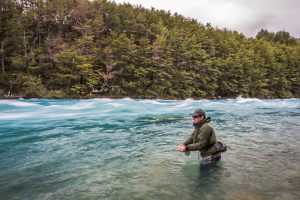Wading in fast-moving water is a thrilling experience that allows anglers to access prime fishing spots often out of reach for those confined to the banks. However, it also comes with risks and challenges that require preparation and skill. In this guide, we’ll explore essential tips for wading safely and effectively in fast-moving water, ensuring your fishing adventure is both enjoyable and safe.
1. Assessing the Water Conditions
Before stepping into fast-moving water, take time to assess the conditions. Look for signs of strong currents, submerged obstacles, and depth changes. Fast water can be deceiving, with powerful undercurrents that aren’t visible from the surface. If you’re unsure about the water’s safety, it’s best to err on the side of caution.
Key Considerations:
- Water Clarity: Clear water allows you to see obstacles and the riverbed, helping you navigate more safely.
- Depth: Use a wading staff or stick to gauge the water’s depth before moving forward.
- Current Speed: If the water is moving too fast to wade safely, it’s best to move to a calmer area.
2. Gear Up Properly
The right gear can make all the difference when wading in fast-moving water. Your equipment should enhance your safety and mobility.
Essential Gear:
- Wading Boots: Choose boots with felt or rubber soles with metal studs to provide traction on slippery rocks.
- Wading Belt: Wear a snug wading belt to prevent water from filling your waders if you slip.
- Wading Staff: A sturdy wading staff offers balance and support, especially in strong currents.
- Life Vest: For deeper or swifter waters, a life vest is an added safety measure.
- Polarized Sunglasses: These help reduce glare on the water’s surface, allowing you to spot hazards more easily.

3. Mastering the Wading Technique
Proper technique is vital to maintaining your balance and minimizing your impact on the environment.
Wading Tips:
- Go Slow: Move slowly and deliberately, sliding your feet along the riverbed rather than lifting them to avoid losing your balance.
- Stay Sideways: Face slightly upstream with your body angled sideways to the current. This reduces resistance and helps maintain stability.
- Use a Wading Staff: Keep your wading staff upstream and slightly ahead to test the ground before each step.
- Avoid Deep Water: Stay in water that’s no deeper than thigh-high to reduce the risk of being swept away by the current.
4. Understand the Riverbed
Different riverbeds present different challenges. Rocky bottoms are common in fast-moving waters and can be slippery or unstable.
Navigating the Riverbed:
- Rocks and Boulders: Step on the tops of rocks rather than between them to avoid trapping your foot.
- Sandy Bottoms: These can shift underfoot, so be cautious when moving through them.
- Vegetation: Be wary of aquatic plants that can tangle your feet or reduce your footing.
5. Safety First: Know When to Retreat
Even experienced anglers can encounter unexpected situations. Knowing when to retreat is as important as knowing how to wade.
Safety Guidelines:
- Watch the Weather: Sudden changes in weather can increase the flow rate of rivers, making wading dangerous.
- Partner Up: If possible, wade with a partner for added safety.
- Listen to Your Instincts: If something feels off, don’t hesitate to get out of the water.
6. Leave No Trace
As always, practice responsible fishing by leaving no trace. Avoid disturbing aquatic habitats and ensure you pack out all trash.
Wading in fast-moving water offers a unique way to connect with nature and enhance your fishing experience. With the right preparation, gear, and mindset, you can navigate these waters safely while enjoying the thrill of the catch.
Image: montanaangler





